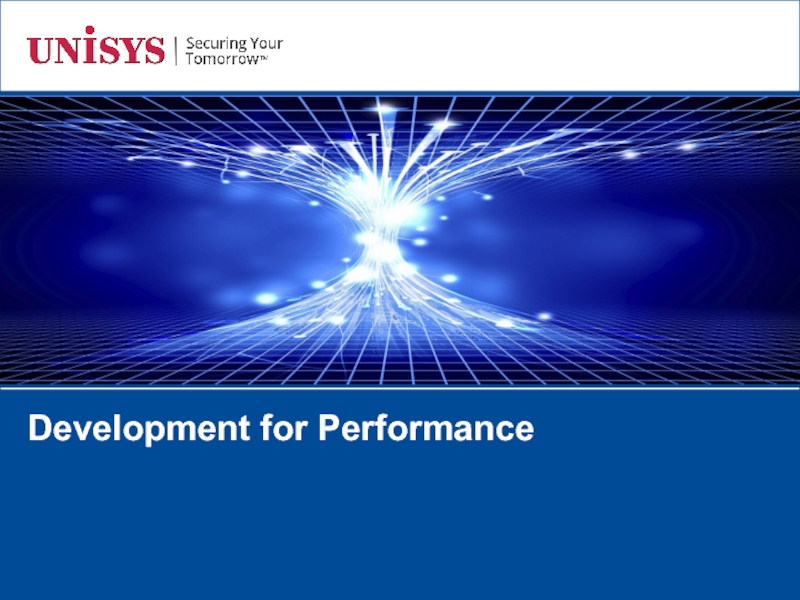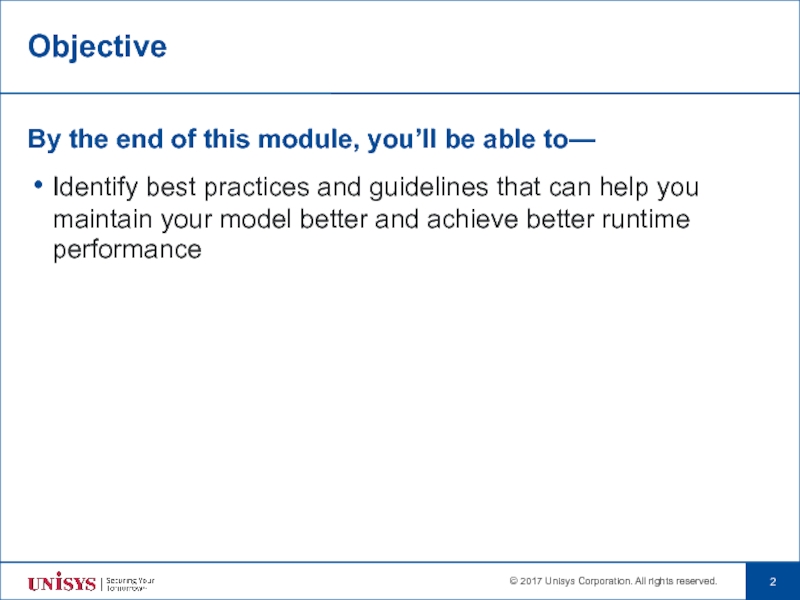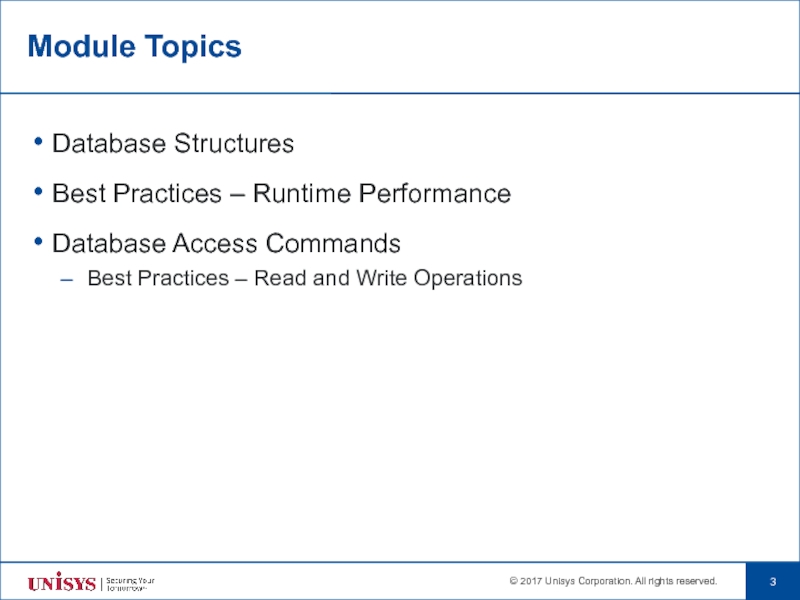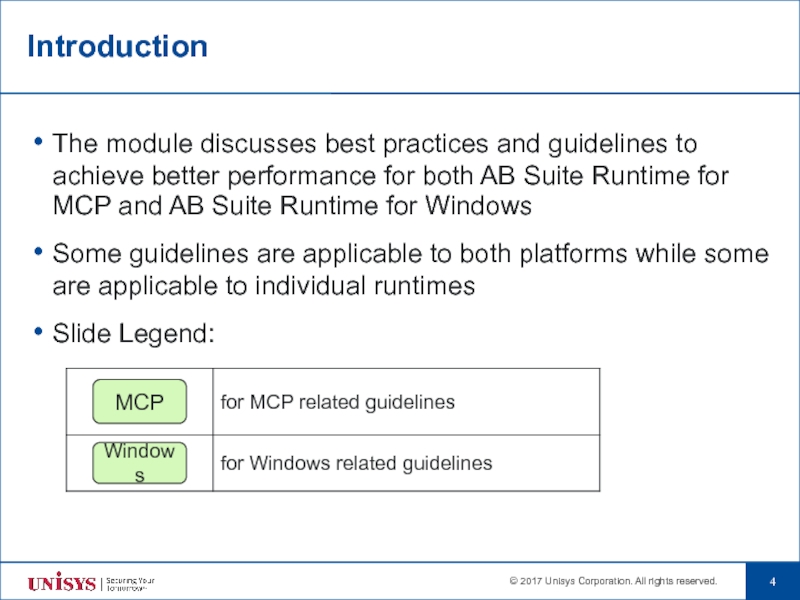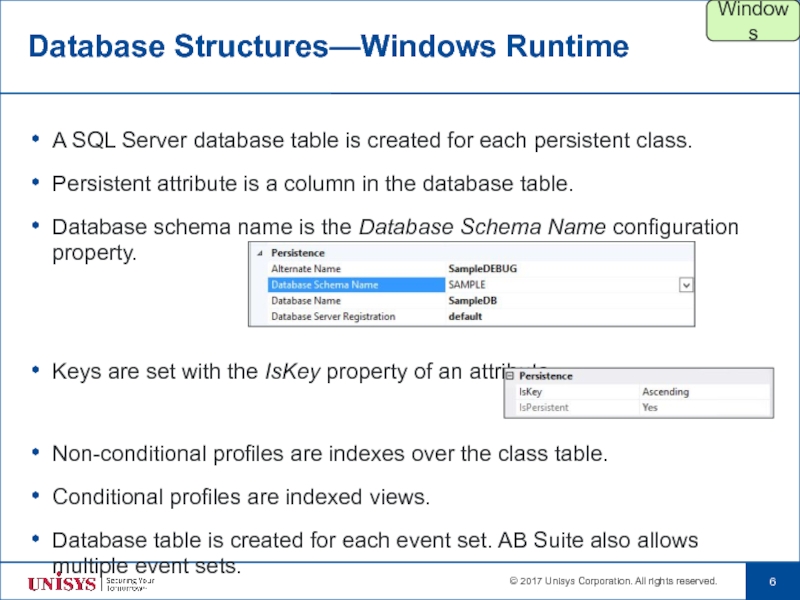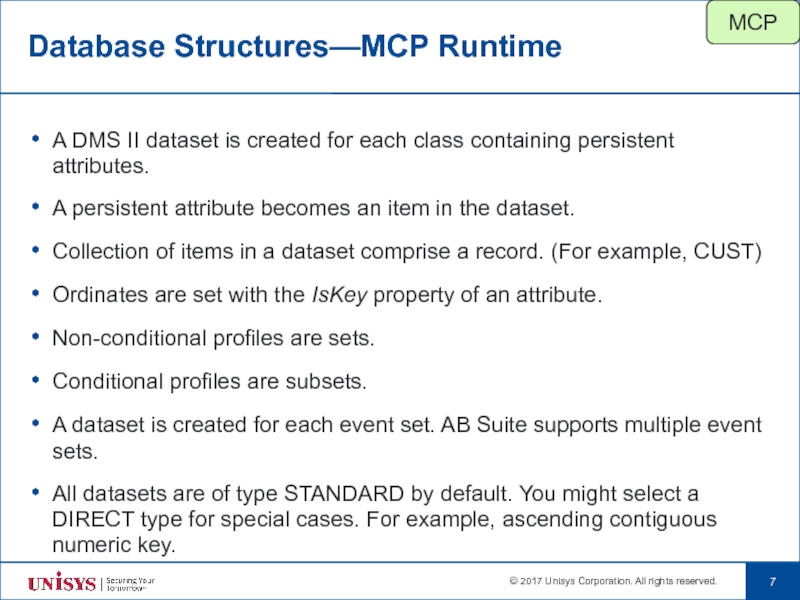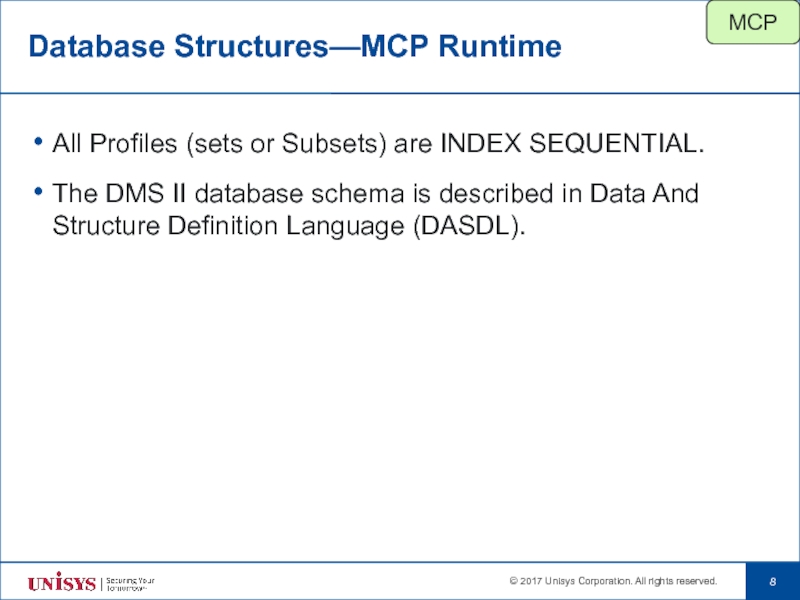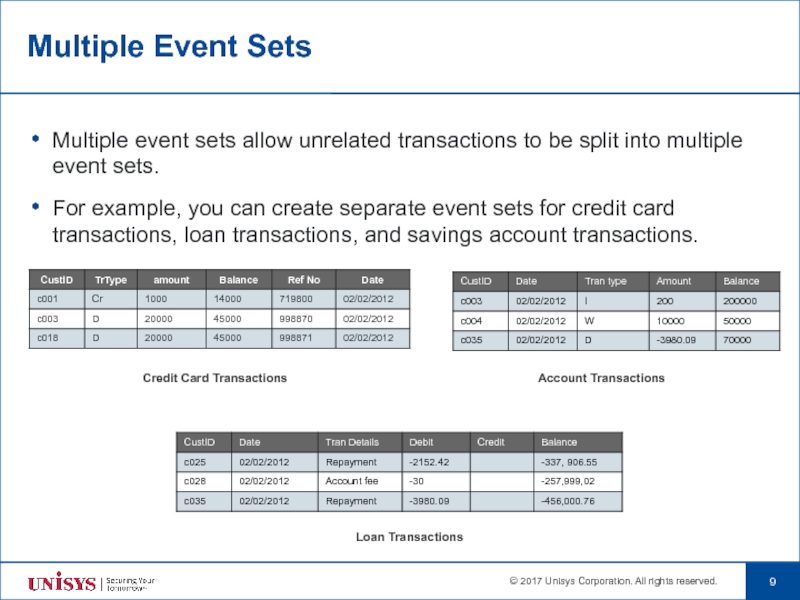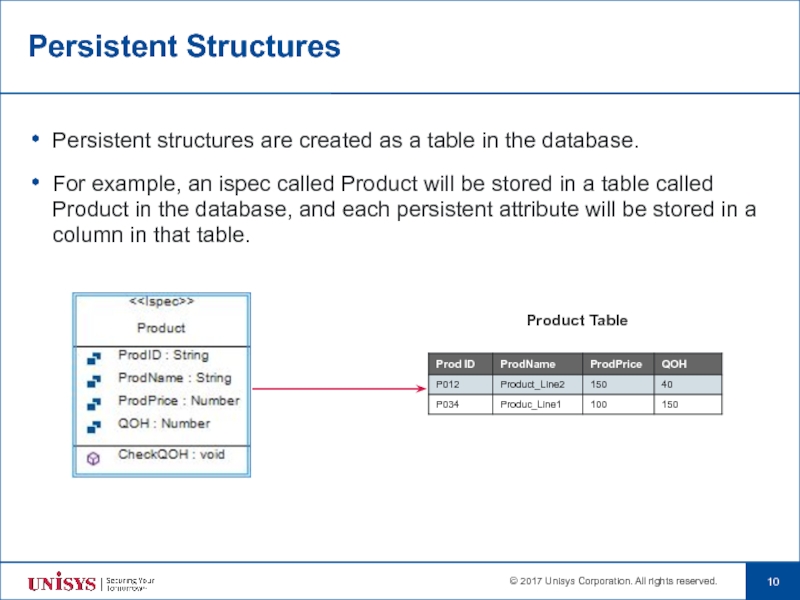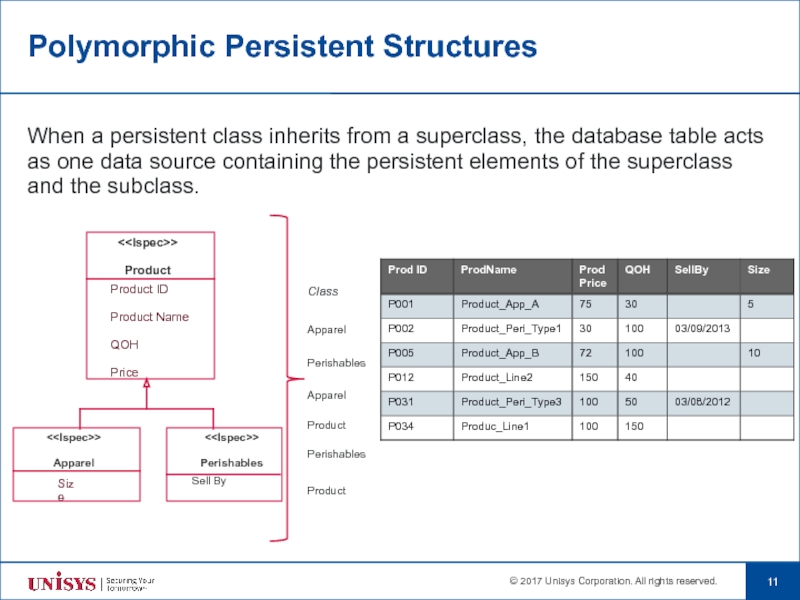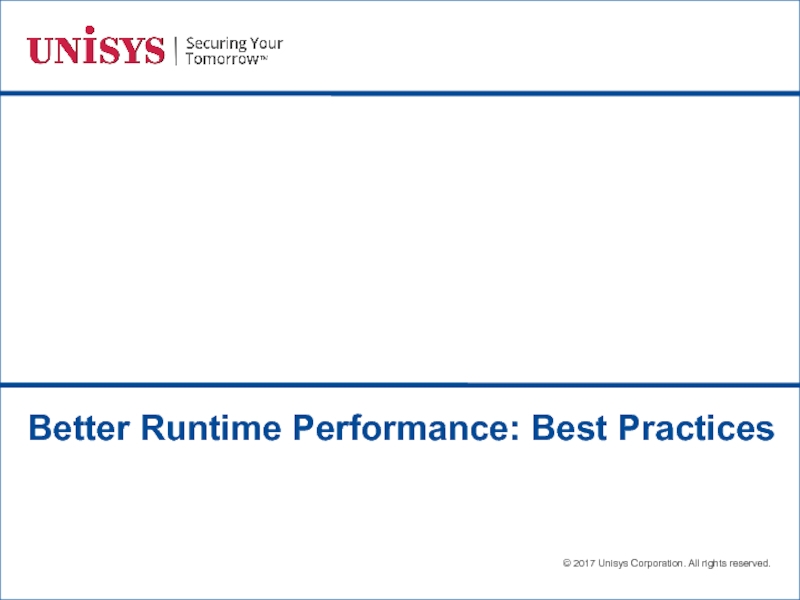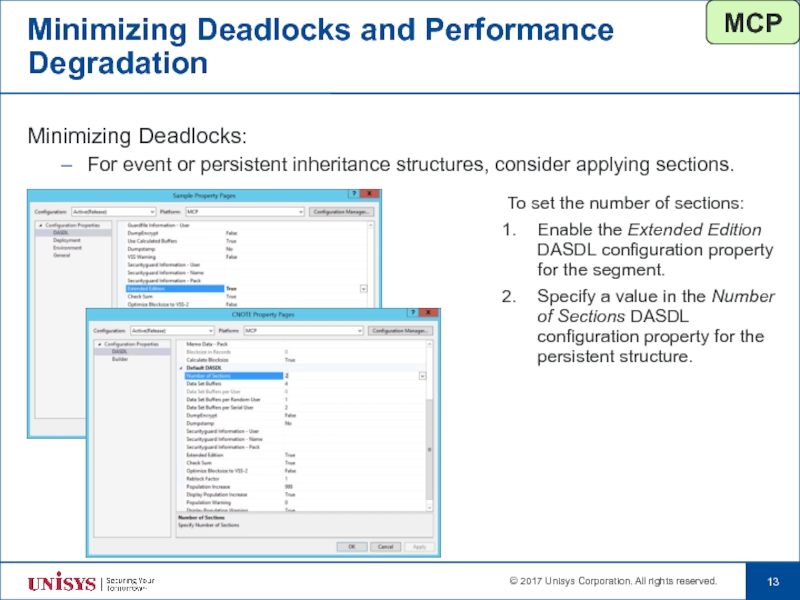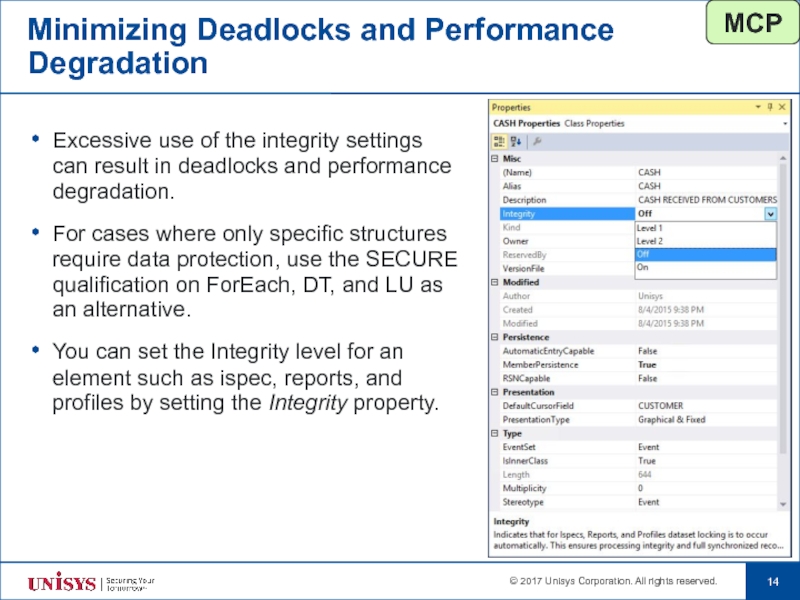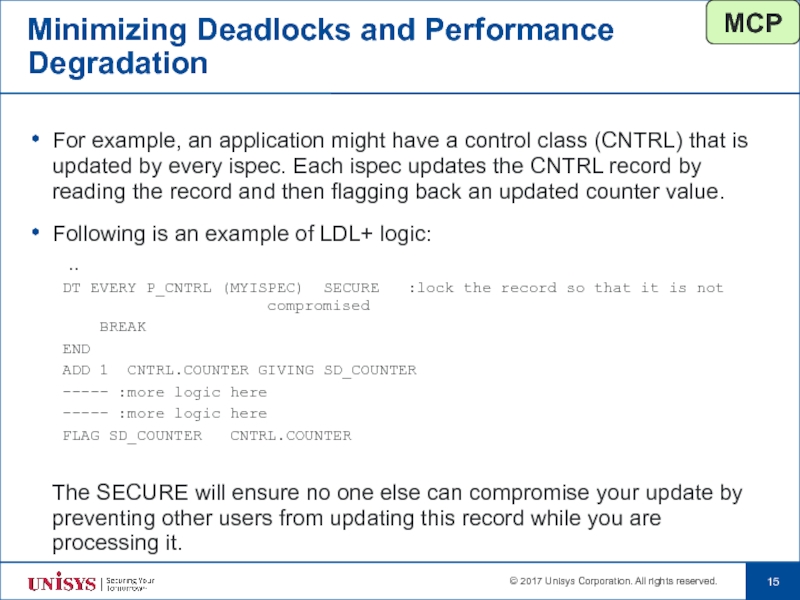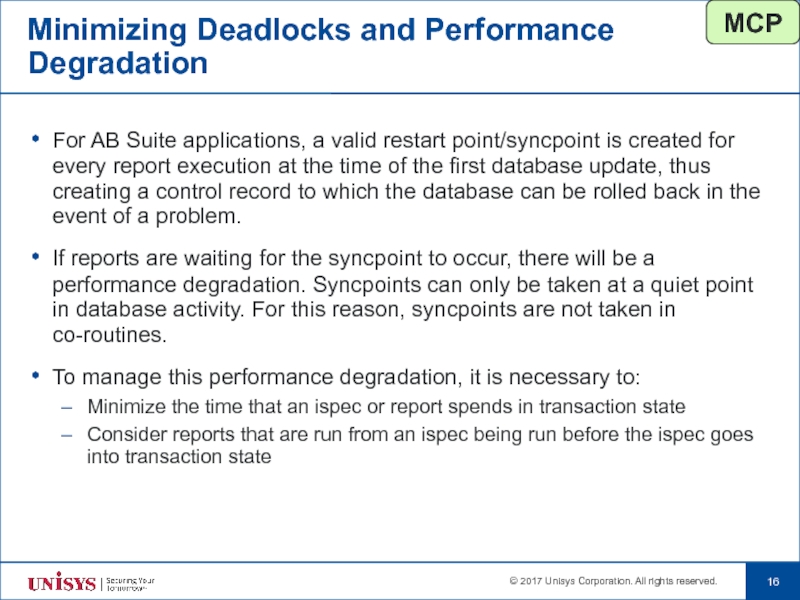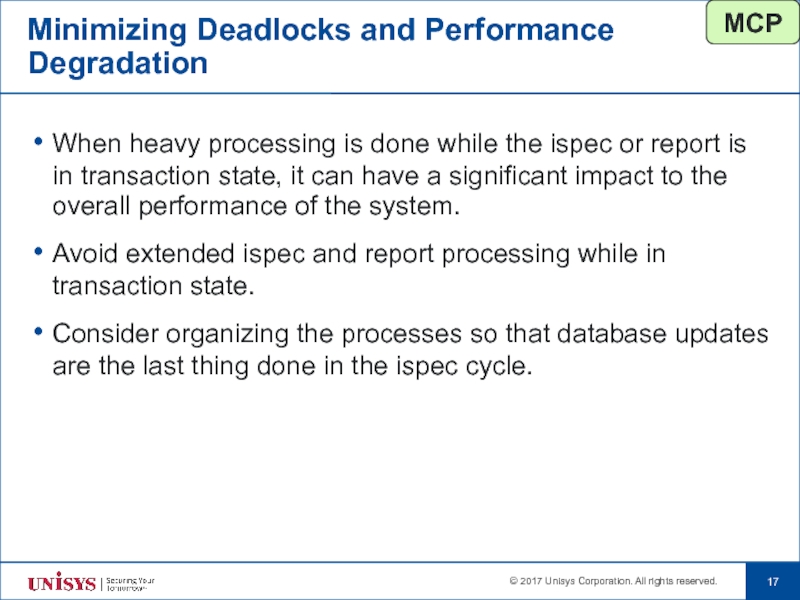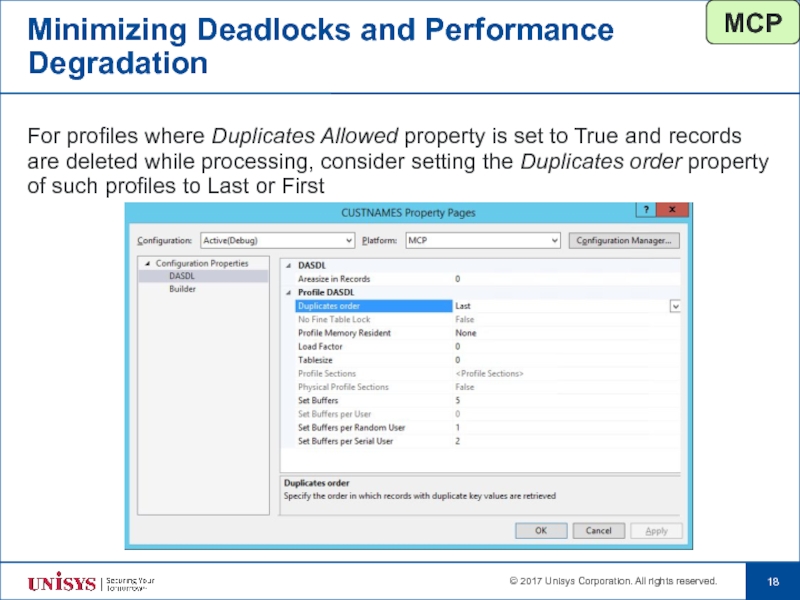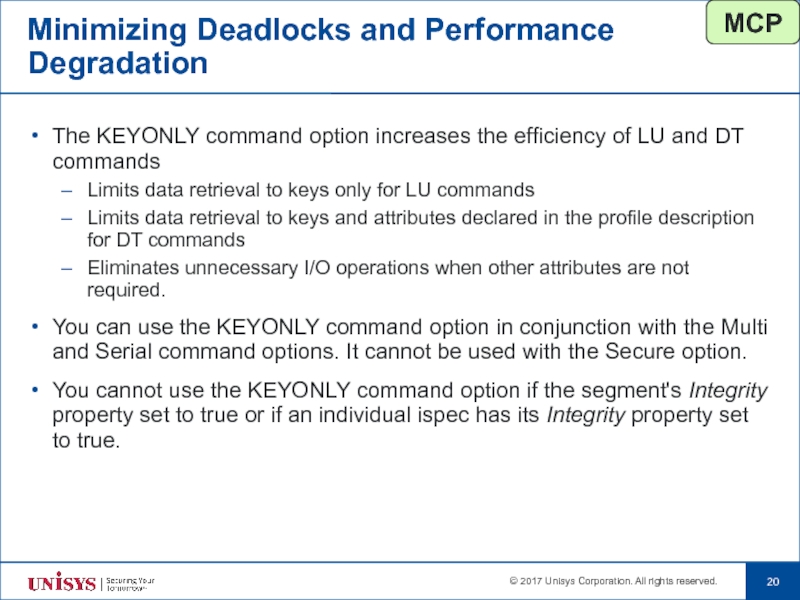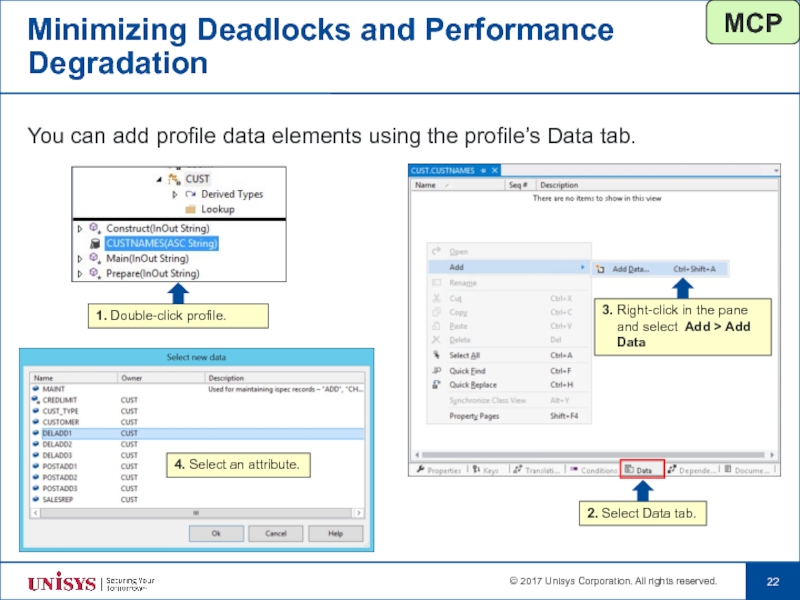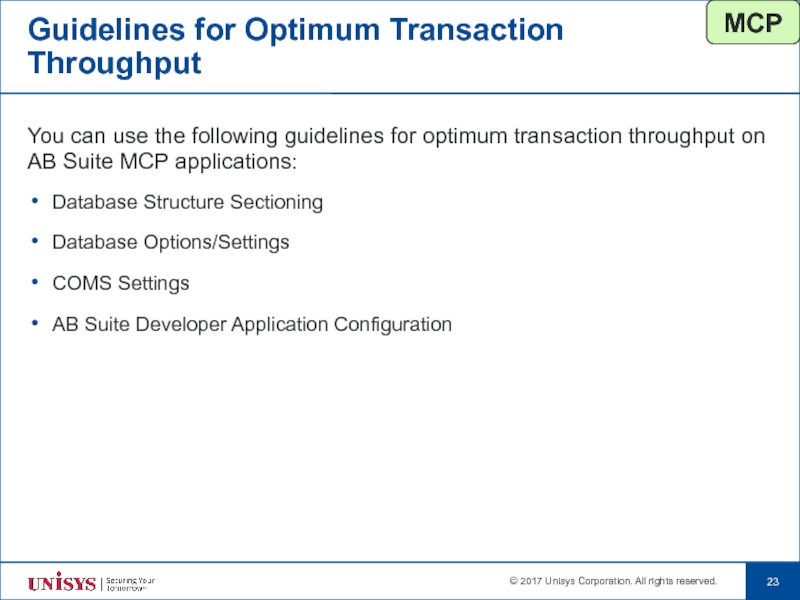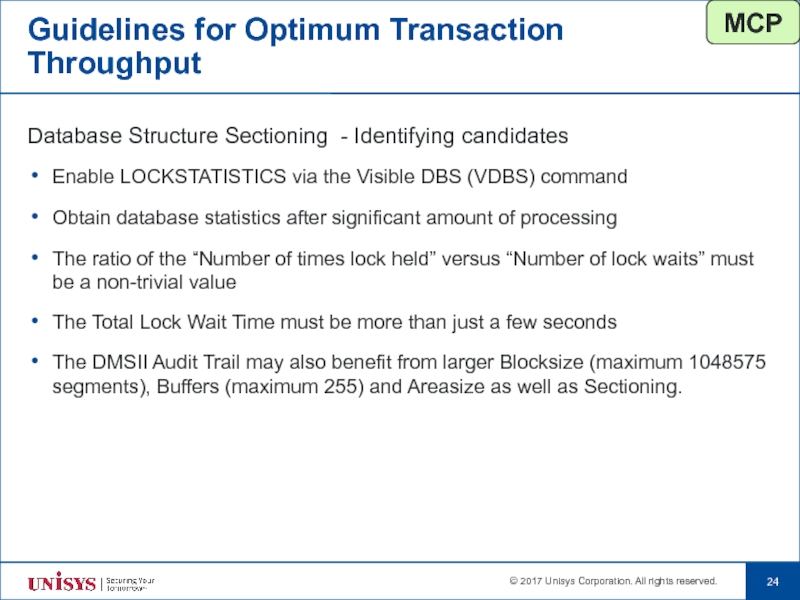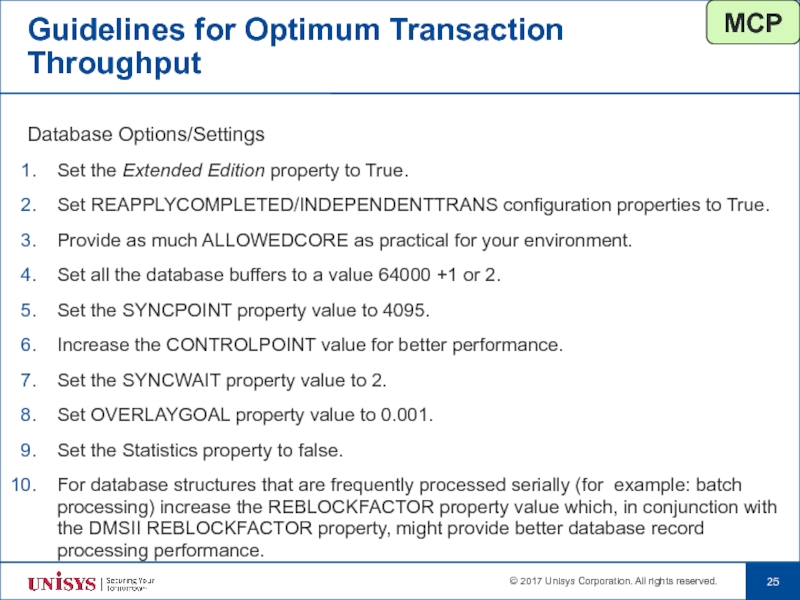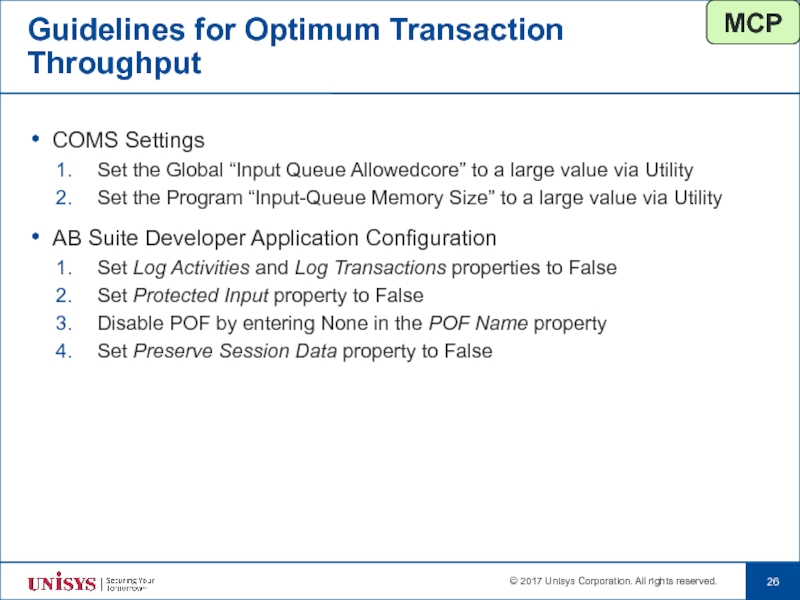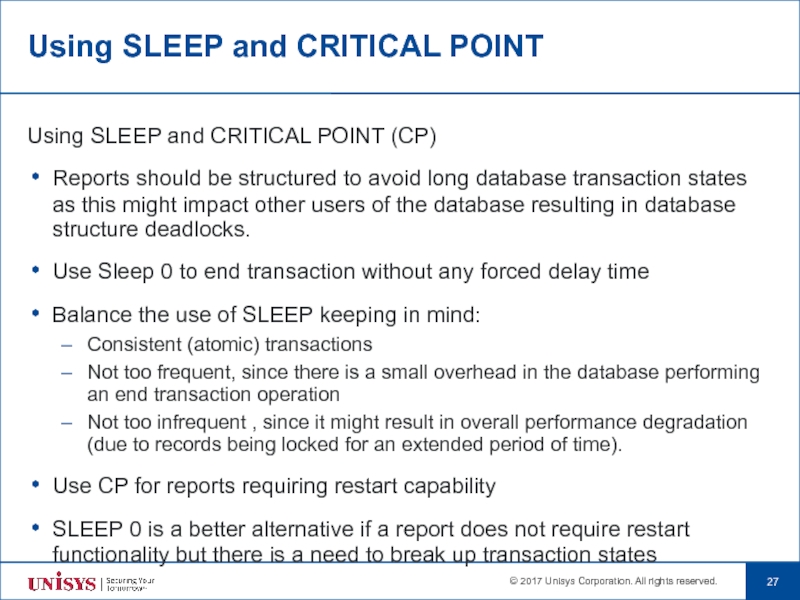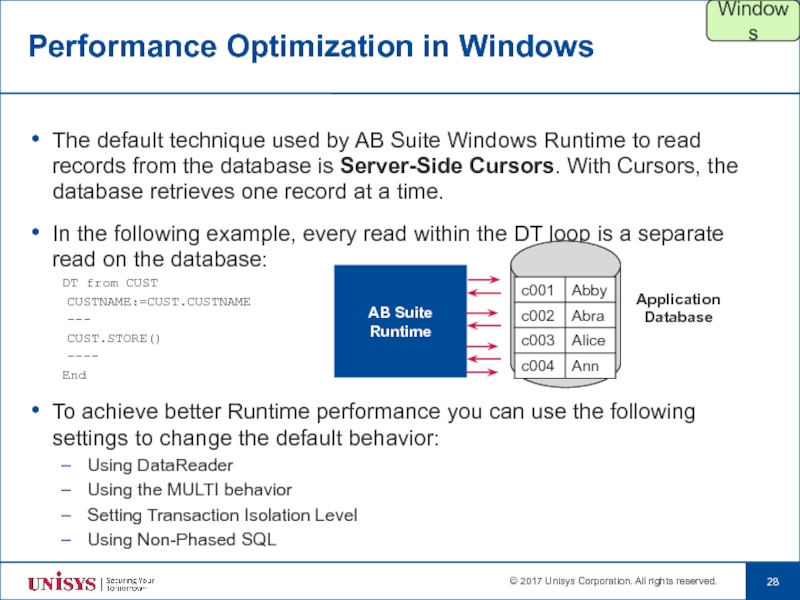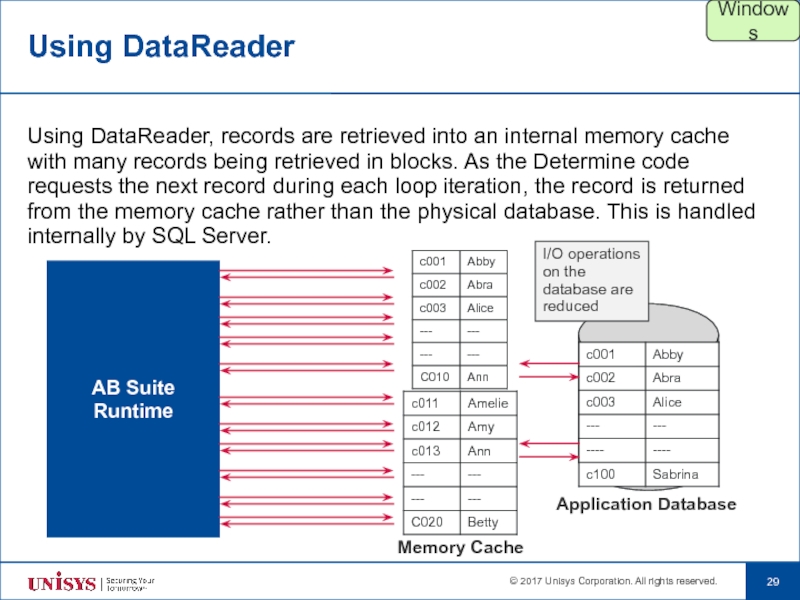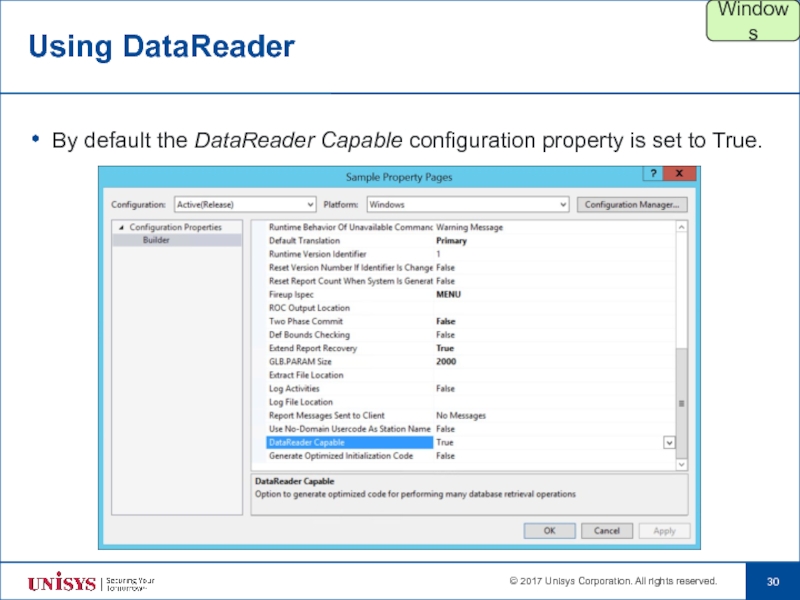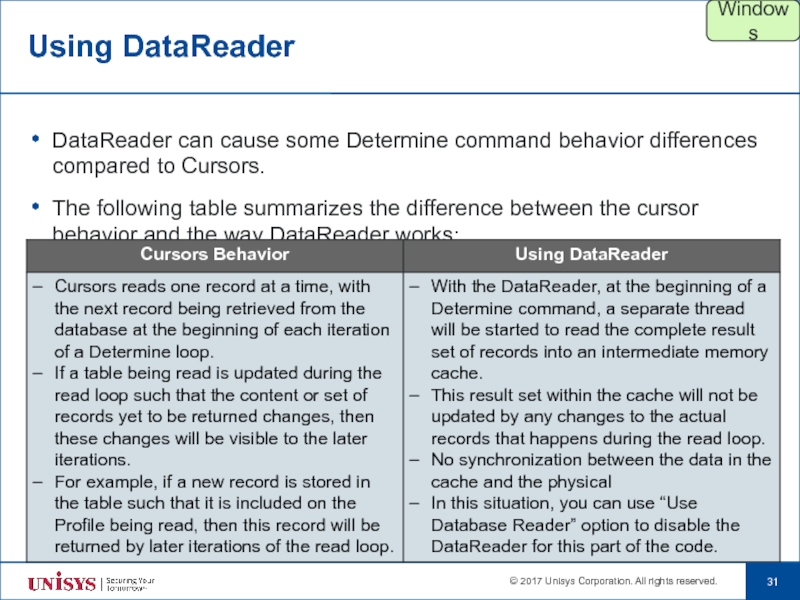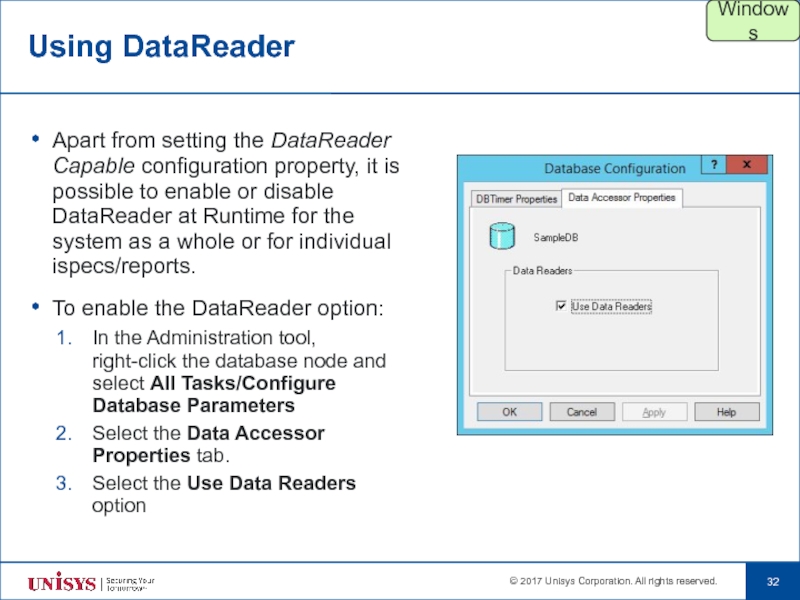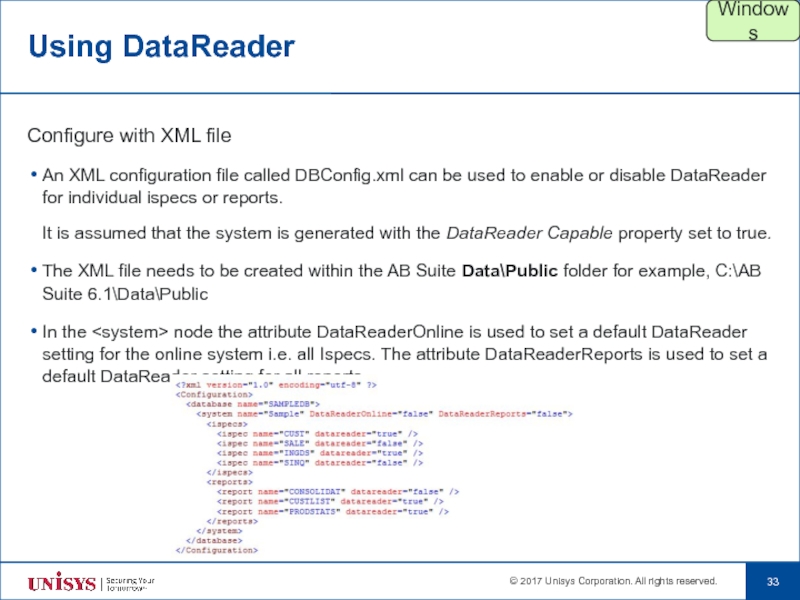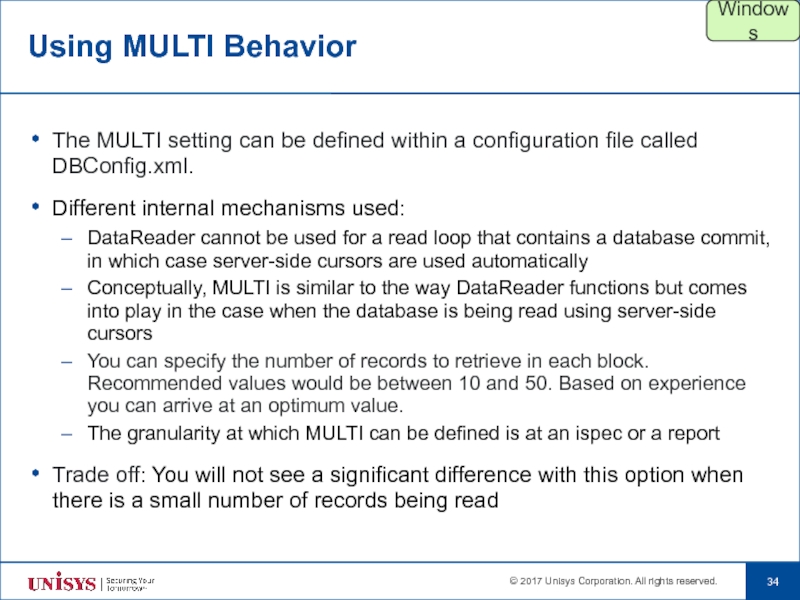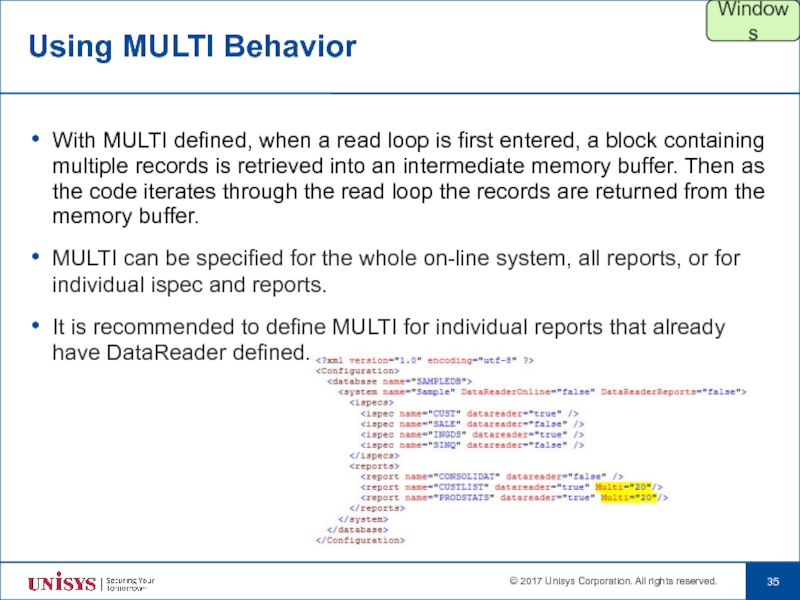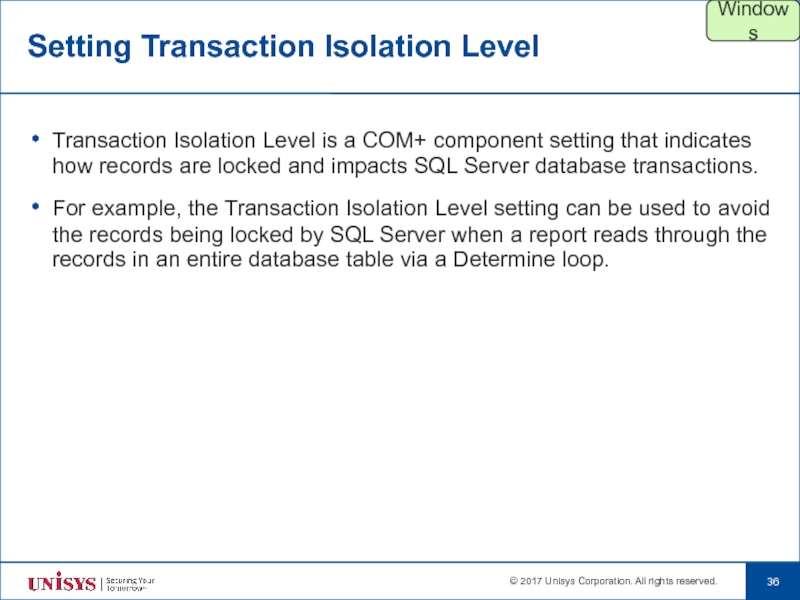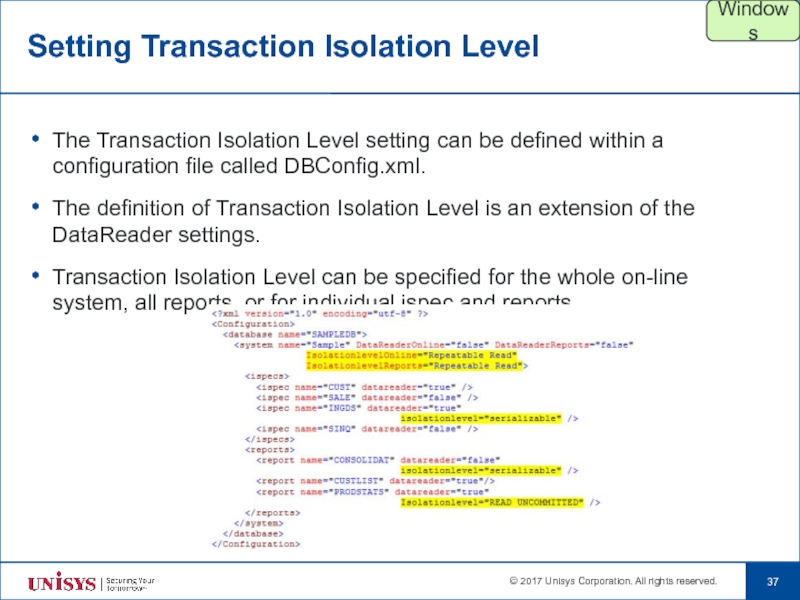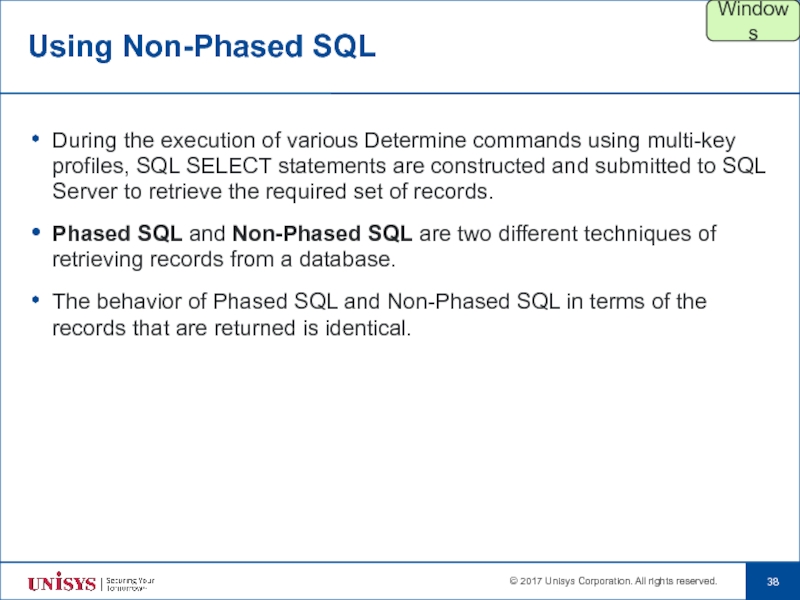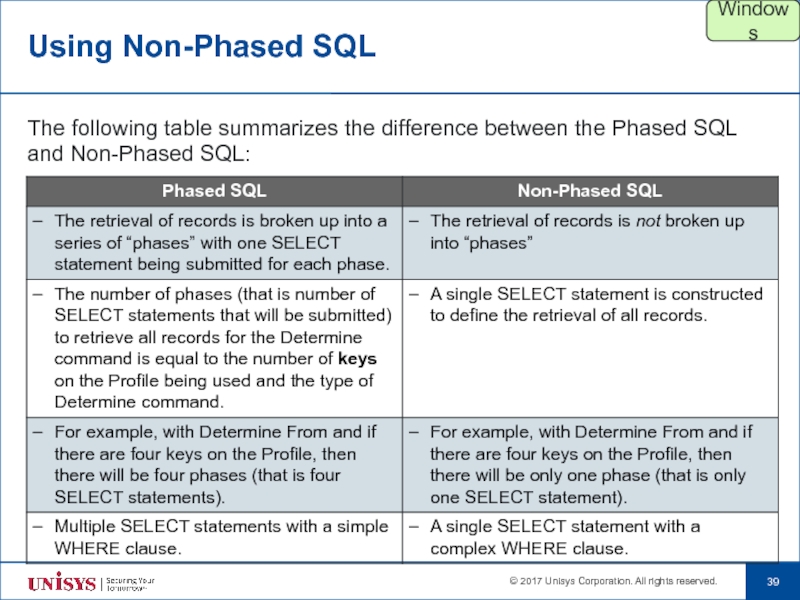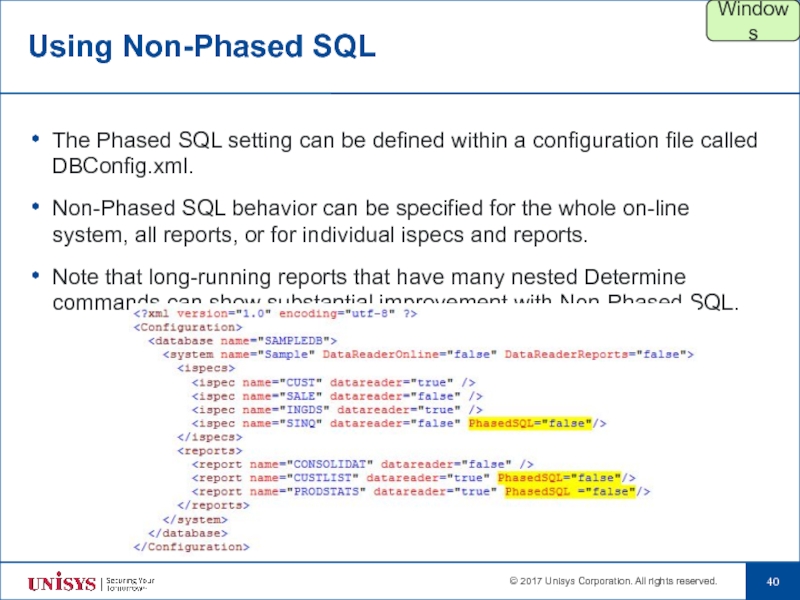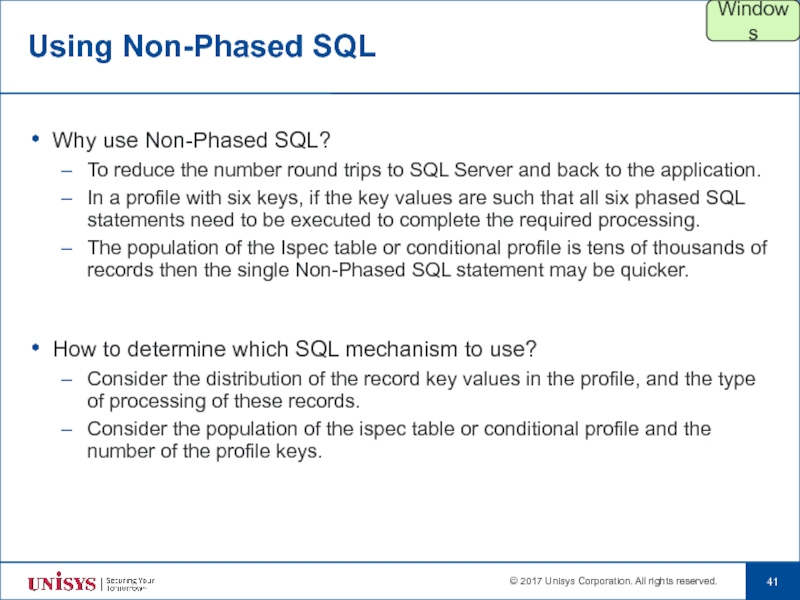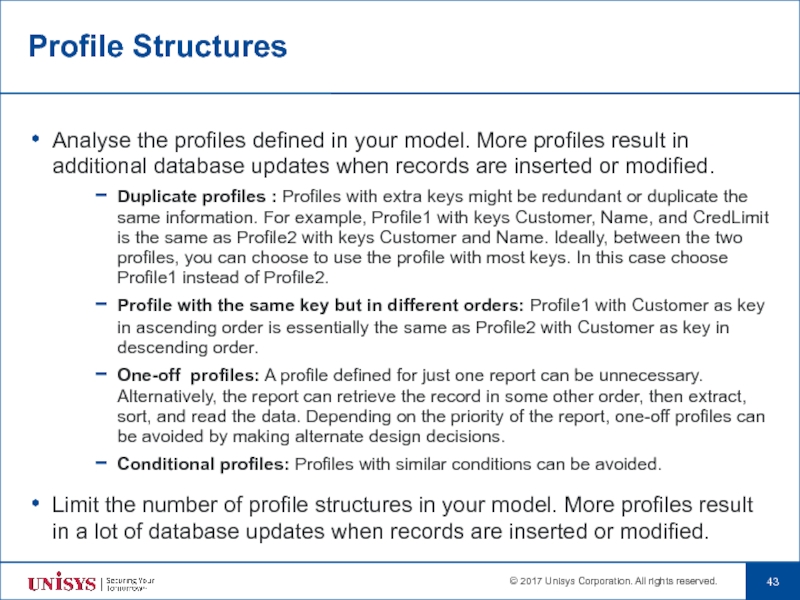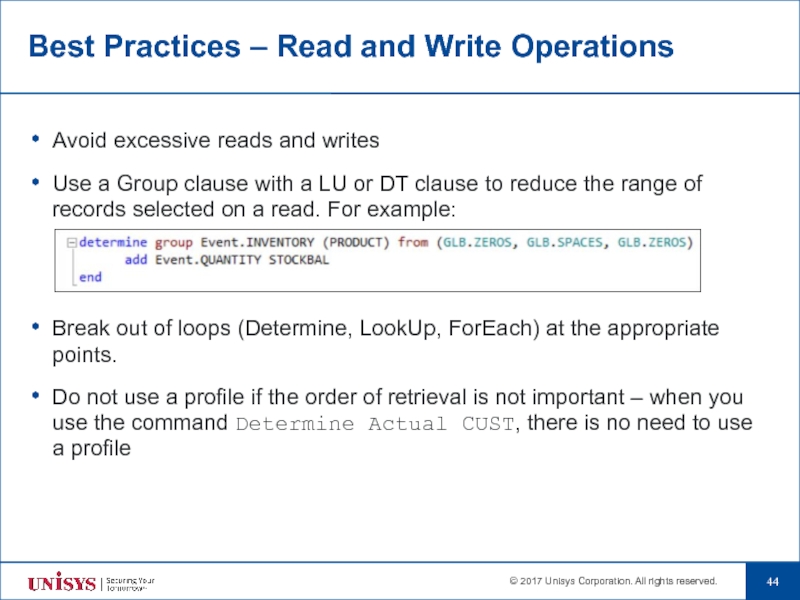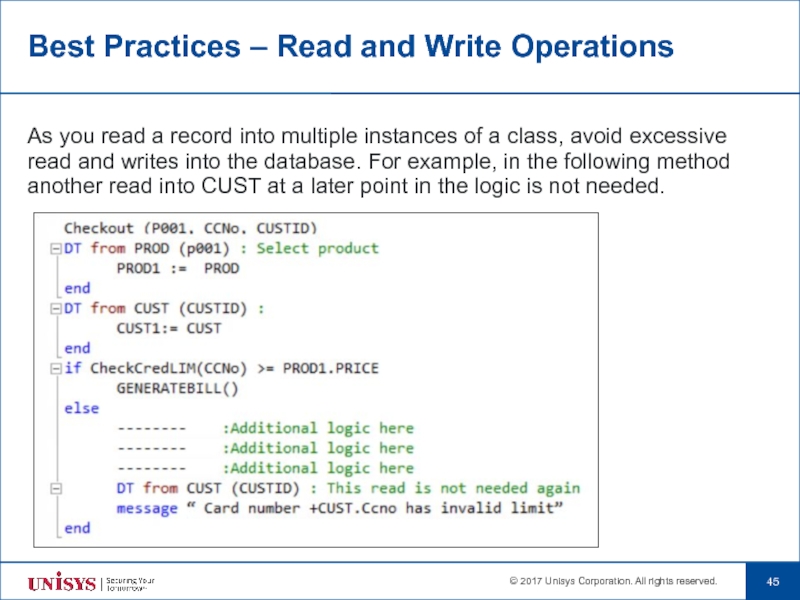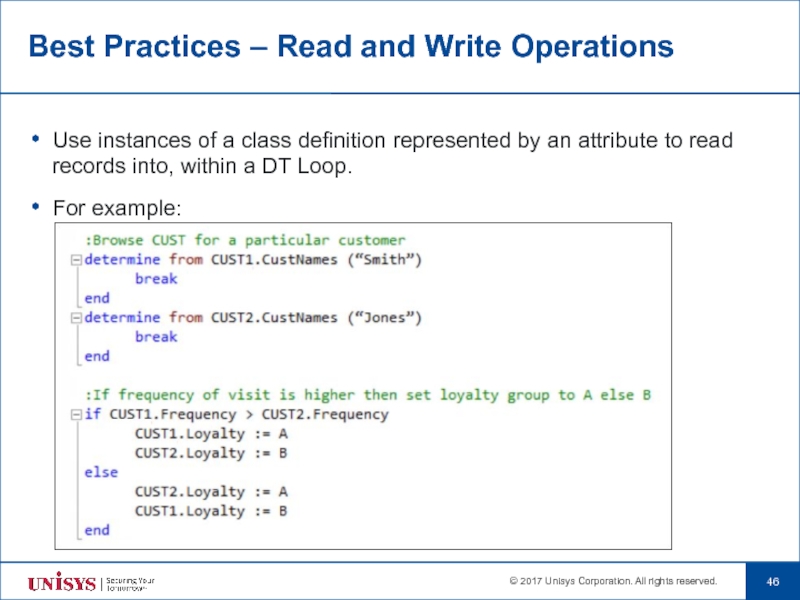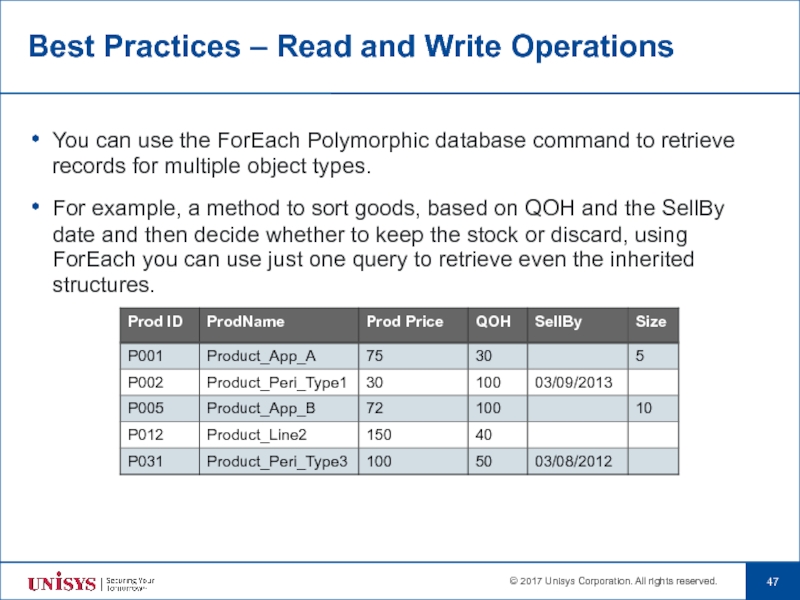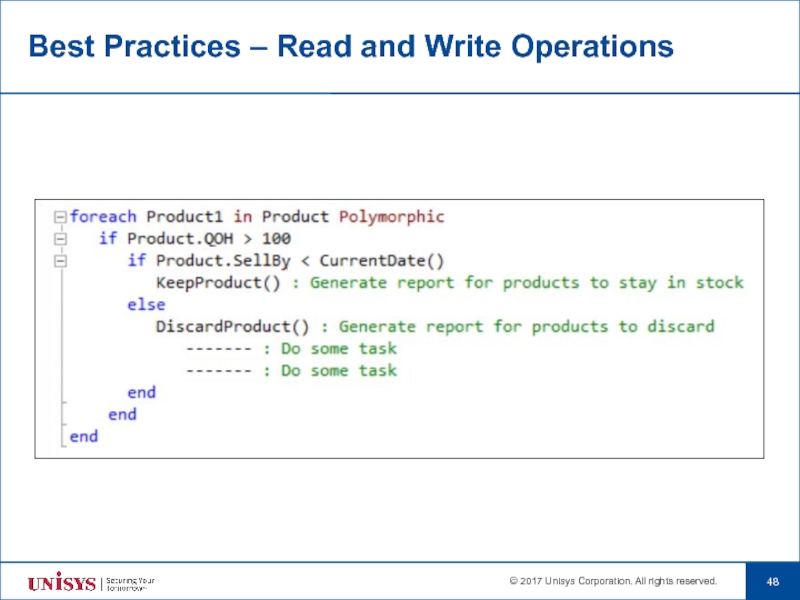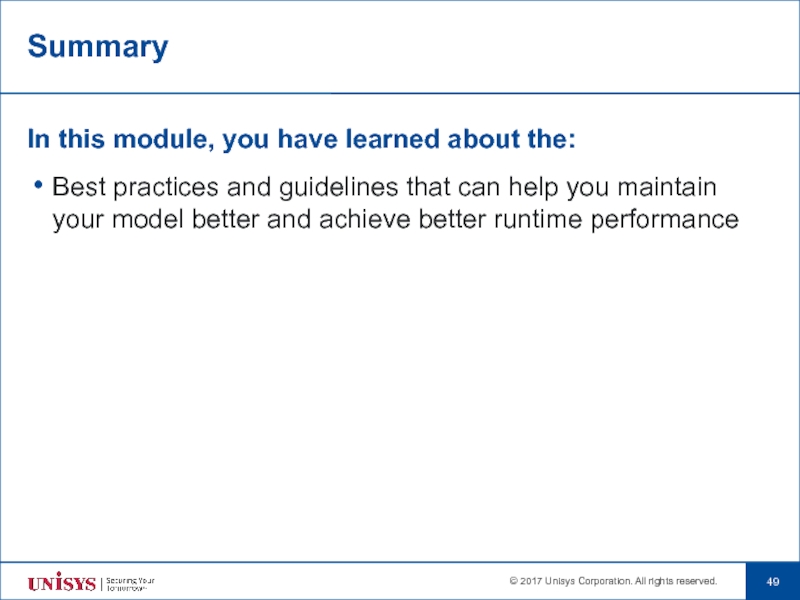- Главная
- Разное
- Дизайн
- Бизнес и предпринимательство
- Аналитика
- Образование
- Развлечения
- Красота и здоровье
- Финансы
- Государство
- Путешествия
- Спорт
- Недвижимость
- Армия
- Графика
- Культурология
- Еда и кулинария
- Лингвистика
- Английский язык
- Астрономия
- Алгебра
- Биология
- География
- Детские презентации
- Информатика
- История
- Литература
- Маркетинг
- Математика
- Медицина
- Менеджмент
- Музыка
- МХК
- Немецкий язык
- ОБЖ
- Обществознание
- Окружающий мир
- Педагогика
- Русский язык
- Технология
- Физика
- Философия
- Химия
- Шаблоны, картинки для презентаций
- Экология
- Экономика
- Юриспруденция
Development for Performance презентация
Содержание
- 1. Development for Performance
- 2. Objective By the end of this module,
- 3. Module Topics Database Structures Best Practices –
- 4. Introduction The module discusses best practices and
- 5. Database Structures
- 6. Database Structures—Windows Runtime A SQL Server
- 7. Database Structures—MCP Runtime A DMS II dataset
- 8. Database Structures—MCP Runtime All Profiles (sets or
- 9. Multiple Event Sets Multiple event sets allow
- 10. Persistent Structures Persistent structures are created as
- 11. Polymorphic Persistent Structures When a persistent class
- 12. Better Runtime Performance: Best Practices
- 13. Minimizing Deadlocks and Performance Degradation Minimizing
- 14. Minimizing Deadlocks and Performance Degradation Excessive
- 15. Minimizing Deadlocks and Performance Degradation For
- 16. Minimizing Deadlocks and Performance Degradation For
- 17. Minimizing Deadlocks and Performance Degradation When
- 18. Minimizing Deadlocks and Performance Degradation For
- 19. Minimizing Deadlocks and Performance Degradation For
- 20. Minimizing Deadlocks and Performance Degradation The
- 21. Minimizing Deadlocks and Performance Degradation The
- 22. Minimizing Deadlocks and Performance Degradation You
- 23. Guidelines for Optimum Transaction Throughput You
- 24. Guidelines for Optimum Transaction Throughput Database
- 25. Guidelines for Optimum Transaction Throughput Database
- 26. Guidelines for Optimum Transaction Throughput COMS
- 27. Using SLEEP and CRITICAL POINT Using SLEEP
- 28. Performance Optimization in Windows The default technique
- 29. Using DataReader Using DataReader, records are retrieved
- 30. Using DataReader By default the DataReader Capable
- 31. Using DataReader DataReader can cause some Determine
- 32. Using DataReader Apart from setting the DataReader
- 33. Using DataReader Configure with XML file An
- 34. Using MULTI Behavior The MULTI setting can
- 35. Using MULTI Behavior With MULTI defined, when
- 36. Setting Transaction Isolation Level Transaction Isolation
- 37. Setting Transaction Isolation Level The Transaction Isolation
- 38. Using Non-Phased SQL During the execution of
- 39. Using Non-Phased SQL The following table summarizes
- 40. Using Non-Phased SQL The Phased SQL setting
- 41. Using Non-Phased SQL Why use Non-Phased SQL?
- 42. Database Access Commands
- 43. Profile Structures Analyse the profiles defined in
- 44. Best Practices – Read and Write Operations
- 45. Best Practices – Read and Write Operations
- 46. Best Practices – Read and Write Operations
- 47. Best Practices – Read and Write Operations
- 48. Best Practices – Read and Write Operations
- 49. Summary In this module, you have learned
Слайд 2Objective
By the end of this module, you’ll be able to—
Identify best
Слайд 3Module Topics
Database Structures
Best Practices – Runtime Performance
Database Access Commands
Best Practices –
Слайд 4Introduction
The module discusses best practices and guidelines to achieve better performance
Some guidelines are applicable to both platforms while some are applicable to individual runtimes
Slide Legend:
MCP
Windows
Слайд 6Database Structures—Windows Runtime
A SQL Server database table is created for
Persistent attribute is a column in the database table.
Database schema name is the Database Schema Name configuration property.
Keys are set with the IsKey property of an attribute.
Non-conditional profiles are indexes over the class table.
Conditional profiles are indexed views.
Database table is created for each event set. AB Suite also allows multiple event sets.
Windows
Слайд 7Database Structures—MCP Runtime
A DMS II dataset is created for each class
A persistent attribute becomes an item in the dataset.
Collection of items in a dataset comprise a record. (For example, CUST)
Ordinates are set with the IsKey property of an attribute.
Non-conditional profiles are sets.
Conditional profiles are subsets.
A dataset is created for each event set. AB Suite supports multiple event sets.
All datasets are of type STANDARD by default. You might select a DIRECT type for special cases. For example, ascending contiguous numeric key.
MCP
Слайд 8Database Structures—MCP Runtime
All Profiles (sets or Subsets) are INDEX SEQUENTIAL.
The DMS
MCP
Слайд 9Multiple Event Sets
Multiple event sets allow unrelated transactions to be split
For example, you can create separate event sets for credit card transactions, loan transactions, and savings account transactions.
Credit Card Transactions
Account Transactions
Loan Transactions
Слайд 10Persistent Structures
Persistent structures are created as a table in the database.
For example, an ispec called Product will be stored in a table called Product in the database, and each persistent attribute will be stored in a column in that table.
Product Table
Слайд 11Polymorphic Persistent Structures
When a persistent class inherits from a superclass, the
< Product ID < Size < Sell By
Product
Product Name
QOH
Price
Apparel
Perishables
Слайд 13Minimizing Deadlocks and Performance
Degradation
Minimizing Deadlocks:
For event or persistent inheritance structures,
MCP
Enable the Extended Edition DASDL configuration property for the segment.
To set the number of sections:
Specify a value in the Number of Sections DASDL configuration property for the persistent structure.
Слайд 14Minimizing Deadlocks and Performance
Degradation
Excessive use of the integrity settings can
For cases where only specific structures require data protection, use the SECURE qualification on ForEach, DT, and LU as an alternative.
You can set the Integrity level for an element such as ispec, reports, and profiles by setting the Integrity property.
MCP
Слайд 15Minimizing Deadlocks and Performance
Degradation
For example, an application might have a
Following is an example of LDL+ logic:
..
DT EVERY P_CNTRL (MYISPEC) SECURE :lock the record so that it is not compromised
BREAK
END
ADD 1 CNTRL.COUNTER GIVING SD_COUNTER
----- :more logic here
----- :more logic here
FLAG SD_COUNTER CNTRL.COUNTER
The SECURE will ensure no one else can compromise your update by preventing other users from updating this record while you are processing it.
MCP
Слайд 16Minimizing Deadlocks and Performance
Degradation
For AB Suite applications, a valid restart
If reports are waiting for the syncpoint to occur, there will be a performance degradation. Syncpoints can only be taken at a quiet point in database activity. For this reason, syncpoints are not taken in co-routines.
To manage this performance degradation, it is necessary to:
Minimize the time that an ispec or report spends in transaction state
Consider reports that are run from an ispec being run before the ispec goes into transaction state
MCP
Слайд 17Minimizing Deadlocks and Performance
Degradation
When heavy processing is done while the
Avoid extended ispec and report processing while in transaction state.
Consider organizing the processes so that database updates are the last thing done in the ispec cycle.
MCP
Слайд 18Minimizing Deadlocks and Performance
Degradation
For profiles where Duplicates Allowed property is
MCP
Слайд 19Minimizing Deadlocks and Performance
Degradation
For very high activity datasets, where Extended
MCP
Слайд 20Minimizing Deadlocks and Performance
Degradation
The KEYONLY command option increases the efficiency
Limits data retrieval to keys only for LU commands
Limits data retrieval to keys and attributes declared in the profile description for DT commands
Eliminates unnecessary I/O operations when other attributes are not required.
You can use the KEYONLY command option in conjunction with the Multi and Serial command options. It cannot be used with the Secure option.
You cannot use the KEYONLY command option if the segment's Integrity property set to true or if an individual ispec has its Integrity property set to true.
MCP
Слайд 21Minimizing Deadlocks and Performance
Degradation
The KEYONLY command option, when used with
Attributes in a profile description are also known as Profile Data elements
Using Profile Data elements eliminates unnecessary I/O operations when other attributes are not required.
Trade off: A Profile Data element is physically stored in two places—in the profile as well as in its associated ispec class.
MCP
Слайд 22Minimizing Deadlocks and Performance
Degradation
You can add profile data elements using
MCP
1. Double-click profile.
2. Select Data tab.
3. Right-click in the pane
and select Add > Add
Data
4. Select an attribute.
Слайд 23Guidelines for Optimum Transaction
Throughput
You can use the following guidelines for
Database Structure Sectioning
Database Options/Settings
COMS Settings
AB Suite Developer Application Configuration
MCP
Слайд 24Guidelines for Optimum Transaction
Throughput
Database Structure Sectioning - Identifying candidates
Enable LOCKSTATISTICS
Obtain database statistics after significant amount of processing
The ratio of the “Number of times lock held” versus “Number of lock waits” must be a non-trivial value
The Total Lock Wait Time must be more than just a few seconds
The DMSII Audit Trail may also benefit from larger Blocksize (maximum 1048575 segments), Buffers (maximum 255) and Areasize as well as Sectioning.
MCP
Слайд 25Guidelines for Optimum Transaction
Throughput
Database Options/Settings
Set the Extended Edition property to
Set REAPPLYCOMPLETED/INDEPENDENTTRANS configuration properties to True.
Provide as much ALLOWEDCORE as practical for your environment.
Set all the database buffers to a value 64000 +1 or 2.
Set the SYNCPOINT property value to 4095.
Increase the CONTROLPOINT value for better performance.
Set the SYNCWAIT property value to 2.
Set OVERLAYGOAL property value to 0.001.
Set the Statistics property to false.
For database structures that are frequently processed serially (for example: batch processing) increase the REBLOCKFACTOR property value which, in conjunction with the DMSII REBLOCKFACTOR property, might provide better database record processing performance.
MCP
Слайд 26Guidelines for Optimum Transaction
Throughput
COMS Settings
Set the Global “Input Queue Allowedcore”
Set the Program “Input-Queue Memory Size” to a large value via Utility
AB Suite Developer Application Configuration
Set Log Activities and Log Transactions properties to False
Set Protected Input property to False
Disable POF by entering None in the POF Name property
Set Preserve Session Data property to False
MCP
Слайд 27Using SLEEP and CRITICAL POINT
Using SLEEP and CRITICAL POINT (CP)
Reports should
Use Sleep 0 to end transaction without any forced delay time
Balance the use of SLEEP keeping in mind:
Consistent (atomic) transactions
Not too frequent, since there is a small overhead in the database performing an end transaction operation
Not too infrequent , since it might result in overall performance degradation (due to records being locked for an extended period of time).
Use CP for reports requiring restart capability
SLEEP 0 is a better alternative if a report does not require restart functionality but there is a need to break up transaction states
Слайд 28Performance Optimization in Windows
The default technique used by AB Suite Windows
In the following example, every read within the DT loop is a separate read on the database:
DT from CUST
CUSTNAME:=CUST.CUSTNAME
---
CUST.STORE()
----
End
To achieve better Runtime performance you can use the following settings to change the default behavior:
Using DataReader
Using the MULTI behavior
Setting Transaction Isolation Level
Using Non-Phased SQL
Windows
AB Suite
Runtime
Application Database
Слайд 29Using DataReader
Using DataReader, records are retrieved into an internal memory cache
AB Suite Runtime
Application Database
Memory Cache
Windows
I/O operations on the database are reduced
Слайд 30Using DataReader
By default the DataReader Capable configuration property is set to
Windows
Слайд 31Using DataReader
DataReader can cause some Determine command behavior differences compared to
The following table summarizes the difference between the cursor behavior and the way DataReader works:
Windows
Слайд 32Using DataReader
Apart from setting the DataReader Capable configuration property, it is
To enable the DataReader option:
In the Administration tool, right-click the database node and select All Tasks/Configure Database Parameters
Select the Data Accessor Properties tab.
Select the Use Data Readers option
Windows
Слайд 33Using DataReader
Configure with XML file
An XML configuration file called DBConfig.xml can
It is assumed that the system is generated with the DataReader Capable property set to true.
The XML file needs to be created within the AB Suite Data\Public folder for example, C:\AB Suite 6.1\Data\Public
In the
Windows
Слайд 34Using MULTI Behavior
The MULTI setting can be defined within a configuration
Different internal mechanisms used:
DataReader cannot be used for a read loop that contains a database commit, in which case server-side cursors are used automatically
Conceptually, MULTI is similar to the way DataReader functions but comes into play in the case when the database is being read using server-side cursors
You can specify the number of records to retrieve in each block. Recommended values would be between 10 and 50. Based on experience you can arrive at an optimum value.
The granularity at which MULTI can be defined is at an ispec or a report
Trade off: You will not see a significant difference with this option when there is a small number of records being read
Windows
Слайд 35Using MULTI Behavior
With MULTI defined, when a read loop is first
MULTI can be specified for the whole on-line system, all reports, or for individual ispec and reports.
It is recommended to define MULTI for individual reports that already have DataReader defined.
Windows
Слайд 36Setting Transaction Isolation Level
Transaction Isolation Level is a COM+ component
For example, the Transaction Isolation Level setting can be used to avoid the records being locked by SQL Server when a report reads through the records in an entire database table via a Determine loop.
Windows
Слайд 37Setting Transaction Isolation Level
The Transaction Isolation Level setting can be defined
The definition of Transaction Isolation Level is an extension of the DataReader settings.
Transaction Isolation Level can be specified for the whole on-line system, all reports, or for individual ispec and reports.
Windows
Слайд 38Using Non-Phased SQL
During the execution of various Determine commands using multi-key
Phased SQL and Non-Phased SQL are two different techniques of retrieving records from a database.
The behavior of Phased SQL and Non-Phased SQL in terms of the records that are returned is identical.
Windows
Слайд 39Using Non-Phased SQL
The following table summarizes the difference between the Phased
Windows
Слайд 40Using Non-Phased SQL
The Phased SQL setting can be defined within a
Non-Phased SQL behavior can be specified for the whole on-line system, all reports, or for individual ispecs and reports.
Note that long-running reports that have many nested Determine commands can show substantial improvement with Non-Phased SQL.
Windows
Слайд 41Using Non-Phased SQL
Why use Non-Phased SQL?
To reduce the number round trips
In a profile with six keys, if the key values are such that all six phased SQL statements need to be executed to complete the required processing.
The population of the Ispec table or conditional profile is tens of thousands of records then the single Non-Phased SQL statement may be quicker.
How to determine which SQL mechanism to use?
Consider the distribution of the record key values in the profile, and the type of processing of these records.
Consider the population of the ispec table or conditional profile and the number of the profile keys.
Windows
Слайд 43Profile Structures
Analyse the profiles defined in your model. More profiles result
Duplicate profiles : Profiles with extra keys might be redundant or duplicate the same information. For example, Profile1 with keys Customer, Name, and CredLimit is the same as Profile2 with keys Customer and Name. Ideally, between the two profiles, you can choose to use the profile with most keys. In this case choose Profile1 instead of Profile2.
Profile with the same key but in different orders: Profile1 with Customer as key in ascending order is essentially the same as Profile2 with Customer as key in descending order.
One-off profiles: A profile defined for just one report can be unnecessary. Alternatively, the report can retrieve the record in some other order, then extract, sort, and read the data. Depending on the priority of the report, one-off profiles can be avoided by making alternate design decisions.
Conditional profiles: Profiles with similar conditions can be avoided.
Limit the number of profile structures in your model. More profiles result in a lot of database updates when records are inserted or modified.
Слайд 44Best Practices – Read and Write Operations
Avoid excessive reads and writes
Use
Break out of loops (Determine, LookUp, ForEach) at the appropriate points.
Do not use a profile if the order of retrieval is not important – when you use the command Determine Actual CUST, there is no need to use a profile
Слайд 45Best Practices – Read and Write Operations
As you read a record
Слайд 46Best Practices – Read and Write Operations
Use instances of a class
For example:
Слайд 47Best Practices – Read and Write Operations
You can use the ForEach
For example, a method to sort goods, based on QOH and the SellBy date and then decide whether to keep the stock or discard, using ForEach you can use just one query to retrieve even the inherited structures.
